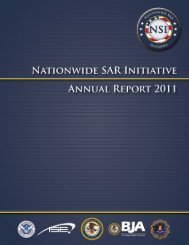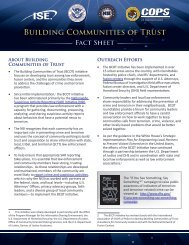NSI Concept of Operations Version 1, December 2008
NSI Concept of Operations Version 1, December 2008
NSI Concept of Operations Version 1, December 2008
You also want an ePaper? Increase the reach of your titles
YUMPU automatically turns print PDFs into web optimized ePapers that Google loves.
<strong>NSI</strong> <strong>Concept</strong> <strong>of</strong> <strong>Operations</strong><br />
Appendix B – The <strong>NSI</strong> as an Integrated ISE Shared Space<br />
Environment<br />
Overview<br />
The goal <strong>of</strong> the <strong>NSI</strong> is that Federal, State, local, tribal, and law enforcement<br />
organization across the United States participate in a standardized, integrated approach<br />
to gathering, documenting, processing, analyzing, and sharing terrorism-related<br />
suspicious activity. The <strong>NSI</strong> is an umbrella initiative encompassing multiple, but<br />
complementary, efforts each <strong>of</strong> which plays an important role in supporting efforts by<br />
Federal, State, local, and tribal agencies to detect and prevent terrorist crimes and to<br />
bring <strong>of</strong>fenders to justice. The emphasis is on improving and standardizing policies,<br />
processes, and procedures for sharing SARs with a potential terrorism nexus rather<br />
than employing specific automated tools or techniques.<br />
Two important components <strong>of</strong> the unified <strong>NSI</strong> process are:<br />
• An ISE initiative that promotes the sharing <strong>of</strong> terrorist-related SARs among<br />
authorized users at local law enforcement agencies, State and major urban area<br />
fusion centers, and federal agencies such as DHS through use <strong>of</strong> distributed ISE<br />
Shared Spaces (dedicated servers located at fusion centers); and<br />
• The FBI’s eGuardian system that uses a centralized database and associated<br />
tools to support JTTFs in assessing and investigating terrorism-related crimes and<br />
also to improve sharing <strong>of</strong> terrorism information between JTTFs and local<br />
agencies. The DoD has also decided to use eGuardian as its repository <strong>of</strong> ISE-<br />
SARs gathered as part <strong>of</strong> the ISE-SAR EE in support <strong>of</strong> its force protection/antiterrorism<br />
mission.<br />
Although the two efforts have some similarities—both enable improved sharing <strong>of</strong><br />
terrorism-related SARs; both implement the IEPD from the ISE-SAR Functional<br />
Standard; and both incorporate provisions that help protect privacy and civil liberties—<br />
they form two distinct but complementary parts <strong>of</strong> a single unified nationwide initiative.<br />
This appendix clarifies the roles <strong>of</strong> eGuardian and ISE Shared Spaces and establishes<br />
fundamental principles for their operational use and interaction during the ISE-SAR EE.<br />
For a number <strong>of</strong> years the FBI has relied on the Guardian system, operating at the<br />
Secret level, as its principal tool for managing assessment and investigation <strong>of</strong><br />
terrorism-related crimes. Although access to classified information by State and local<br />
agencies has expanded over the last few years, it is still far from universal.<br />
Consequently, the information in Guardian is still inaccessible to many Federal, State,<br />
and local law enforcement agencies.<br />
35






